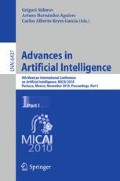Abstract
Nowadays efficient methods for air quality assessment are needed in order to detect negative problems in human health. A new computational model is developed in order to evaluate toxic compounds in air of urban areas that can be harmful in sensitive people, affecting their normal activities. Using the Gamma classifier (Γ), environmental variables are assessed determining their negative impact in air quality based on their toxicity limits, the average of the frequency and the deviations of toxic tests. A fuzzy inference system uses the environmental classifications providing an air quality index, which describes the pollution levels in five stages: excellent, good, regular, bad and danger respectively.
Access this chapter
Tax calculation will be finalised at checkout
Purchases are for personal use only
Preview
Unable to display preview. Download preview PDF.
References
[USEPA] United States Environmental Protection Agency (2009), http://www.epa.gov (accessed August 2009)
[SMA] Secretaría del Medio Ambiente (2009), http://www.sma.df.gob.mx (accessed August 2009)
[PAHO] Pan American Health Organization (2009), http://www.paho.org (accessed August 2009)
Muttil, N., Chau, K.N.: Neural network and genetic programming for modeling coastal algal blooms. International Journal of Environment and Pollution 28(3-4), 223–238 (2006)
Yañez, C., López, I., De la Luz, G.: Analysis and prediction of air quality data with the Gamma Classifier. LNCS, pp. 651–658. Springer, Heidelberg (2008)
Lin, J.Y., Cheng, C.T., Chau, K.W.: Using support vector machines for longterm discharge prediction. Hydrological Sciences Journal 5(4), 599–612 (2006)
Secretaría del Medio Ambiente, Norma Ambiental para el Distrito Federal NADF-009-AIRE-2006, Gaceta Oficial del Distrito Federal (2006)
Dovilė, L.: Nitrogen dioxide concentrations and their relation with meteorological conditions and some environmental factors in Kaunas. Environmental Research, Engineering and Management 1, 21–27 (2008)
[EPA] Environmental Protection Agency, Air Quality Criteria for Carbon Monoxide, United States (2000)
Arreola, J., González, G.: Análisis espectral del viento y partículas menores de 10 micrómetros (PM10) en el área metropolitana de Monterrey, México. Revista Internacional de Contaminación Ambiental 15, 95–102 (1999)
Bell, M., McDermott, A., Zeger, S., Samet, J., Dominici, F.: Ozone and short-term mortality, in 95 US urban communities, 1987-2000. Journal of American Medical Association 292, 2372–2378 (2004)
[SIMAT] Atmospheric Monitoring System (2009), http://www.sma.df.gob.mx/simat2 (accessed August 2009)
[REDMA] Manual Atmospheric Monitoring Network (2009), http://www.sma.df.gob.mx/simat/pnredma2.htm (accessed August 2009)
[RAMA] Automatic Atmospheric Monitoring Network (2009), http://www.sma.df.gob.mx/simat/pnrama2.htm (accessed August 2009)
Soler, V.: Lógica Difusa Aplicada a Conjuntos Imbalanceados: Aplicación a la Detección del Síndrome de Down, Departament de Microelectrònica i Sistemes Electrònics, Universitat Autònoma de Barcelona, Ph. D. Thesis (2007)
Ocampo, W., Ferré, N., Domingo, J., Schuhmacher, M.: Assessing water quality in rivers with fuzzy inference systems: A case study. In: Environment International, vol. 32, pp. 733–742. Elsevier, Amsterdam (2006)
Chow, M.: Methodologies of using neural network and fuzzy logic technologies for motor incipient fault detection. World Scientific, Singapore (1997)
Author information
Authors and Affiliations
Editor information
Editors and Affiliations
Rights and permissions
Copyright information
© 2010 Springer-Verlag Berlin Heidelberg
About this paper
Cite this paper
Carbajal Hernández, J.J., Sánchez Fernández, L.P., Manrique Ramírez, P. (2010). Environmental Pattern Recognition for Assessment of Air Quality Data with the Gamma Classifier. In: Sidorov, G., Hernández Aguirre, A., Reyes García, C.A. (eds) Advances in Artificial Intelligence. MICAI 2010. Lecture Notes in Computer Science(), vol 6437. Springer, Berlin, Heidelberg. https://doi.org/10.1007/978-3-642-16761-4_38
Download citation
DOI: https://doi.org/10.1007/978-3-642-16761-4_38
Publisher Name: Springer, Berlin, Heidelberg
Print ISBN: 978-3-642-16760-7
Online ISBN: 978-3-642-16761-4
eBook Packages: Computer ScienceComputer Science (R0)

